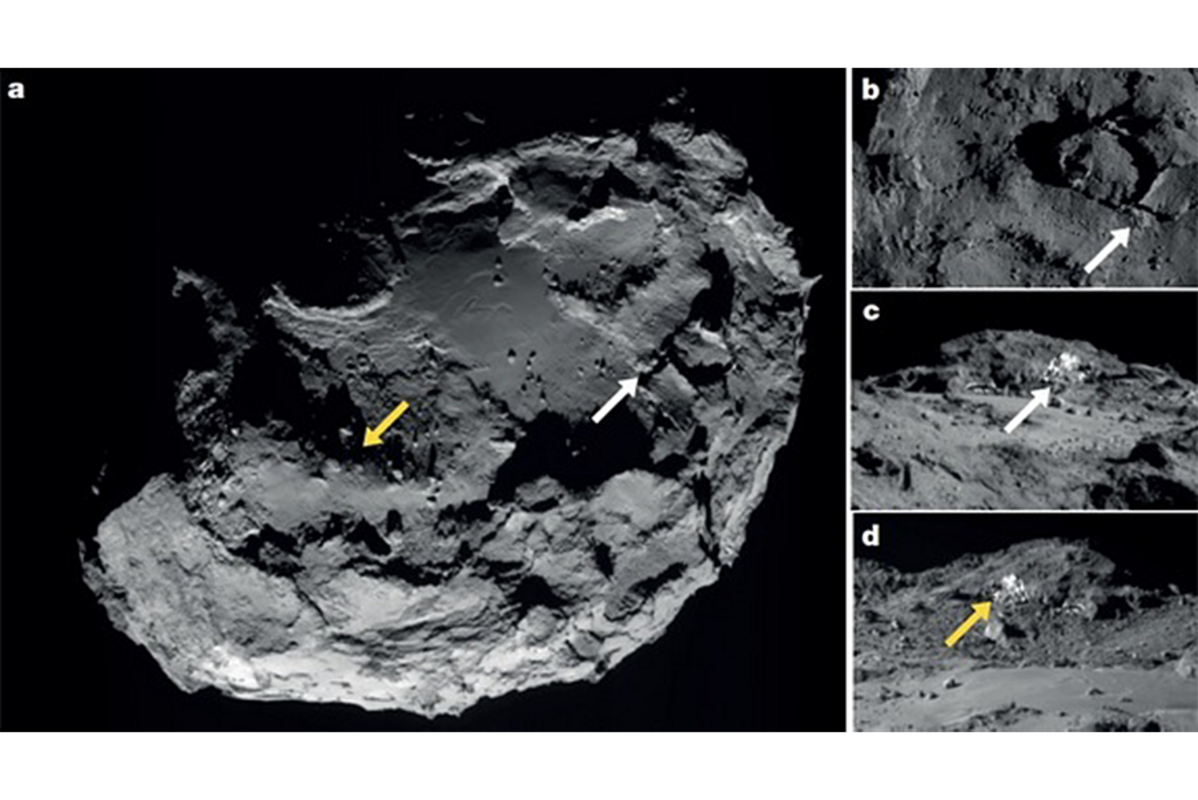European space probe finds water on surface of comet
Loading...
A European spacecraft has spotted water ice on the surface of a comet, shedding new light on the formation and evolution of the icy object.
The European Space Agency's Rosetta spacecraft detected relatively large grains of water ice in two different places on the surface of , which the probe has been orbiting since August 2014.
These big grains may have formed after heat from the sun sublimated (or vaporized) buried water ice, which then recondensed and was redeposited in subsurface layers, without ever leaving Comet 67P, researchers said. []
"If the thin ice-rich layers that we see exposed close to the surface are the result of the comet's activity, then they represent its evolution, and it does not necessarily require global layering to have occurred early in the comet's formation history," study lead author Gianrico Filacchione, of the Institute for Space Astrophysics and Planetology at the National Institute for Astrophysics in Rome, told Space.com via email.
are made primarily of water ice, but the stuff is rarely observed on their frigid surfaces. Indeed, the 2.5-mile-wide (4 kilometers) Comet 67P appears to be covered by a nearly uniform layer of dark dust, Filacchione said.
"We have measured that the surface reflects only a few percent of solar light," he said. "Ices are not stable for a long time on the surface of the nucleus because, during the perihelion passage [closest approach to the sun], they sublimate, originating the gaseous coma."
Filacchione and his colleagues studied observations of Comet 67P made by Rosetta's Visual and Infrared Thermal Imaging Spectrometer (VIRTIS) instrument. VIRTIS detected surface water ice in two separate, 3.3-foot-wide (1 meter) areas within a region of the comet dubbed Imhotep, the researchers report in a study published online today (Jan. 13) in the .
Both patches are associated with cliff walls and recent debris falls, which likely explains why the ice did not quickly boil away into space.
"The two water-ice-rich areas detected by VIRTIS were, in fact, scarcely illuminated by the sun at the time of their observation," Filacchione said.
The instrument's observations suggest that the water ice is present in two different grain sizes, he added — those on the micrometer (one-millionth of a meter) scale, and those with an average size of about 2 millimeters (0.08 inches).
The 2-millimeter grains are particularly intriguing, Filacchione said, because they can be explained by the growth of secondary ice crystals. These secondary crystals can form via "sintering" (the compaction of smaller grains) or via the sublimation process outlined above.
Lab work suggests that sublimation could well be involved — and, therefore, that layers of water ice have been deposited beneath 67P's surface over the course of the comet's history.
"This idea is supported by laboratory experiments that simulate the sublimation behavior of ice buried under dust, showing that more than 80 percent of the sublimating ice is not released through the dust mantle but is redeposited below the surface, resulting in the formation of ice layers immediately below the dust crust," Filacchione said.
The Rosetta mission blasted off in March 2004 and, a decade later, in August 2014, became the first spacecraft ever to orbit a comet. In November 2014, Rosetta scored another spaceflight first when it dropped a onto the surface of 67P.
The comet made its closest approach to in August 2015 and is now zooming back out toward the outer solar system. Rosetta will continue making measurements from orbit until Sept. 30, when it is scheduled to end its historic mission with a slow-motion crash landing onto the comet's surface.
Follow Mike Wall on Twitter �����Ի���. Follow us ,�����ǰ�. Originally published on .
Copyright 2016 , a Purch company. All rights reserved. This material may not be published, broadcast, rewritten or redistributed.




